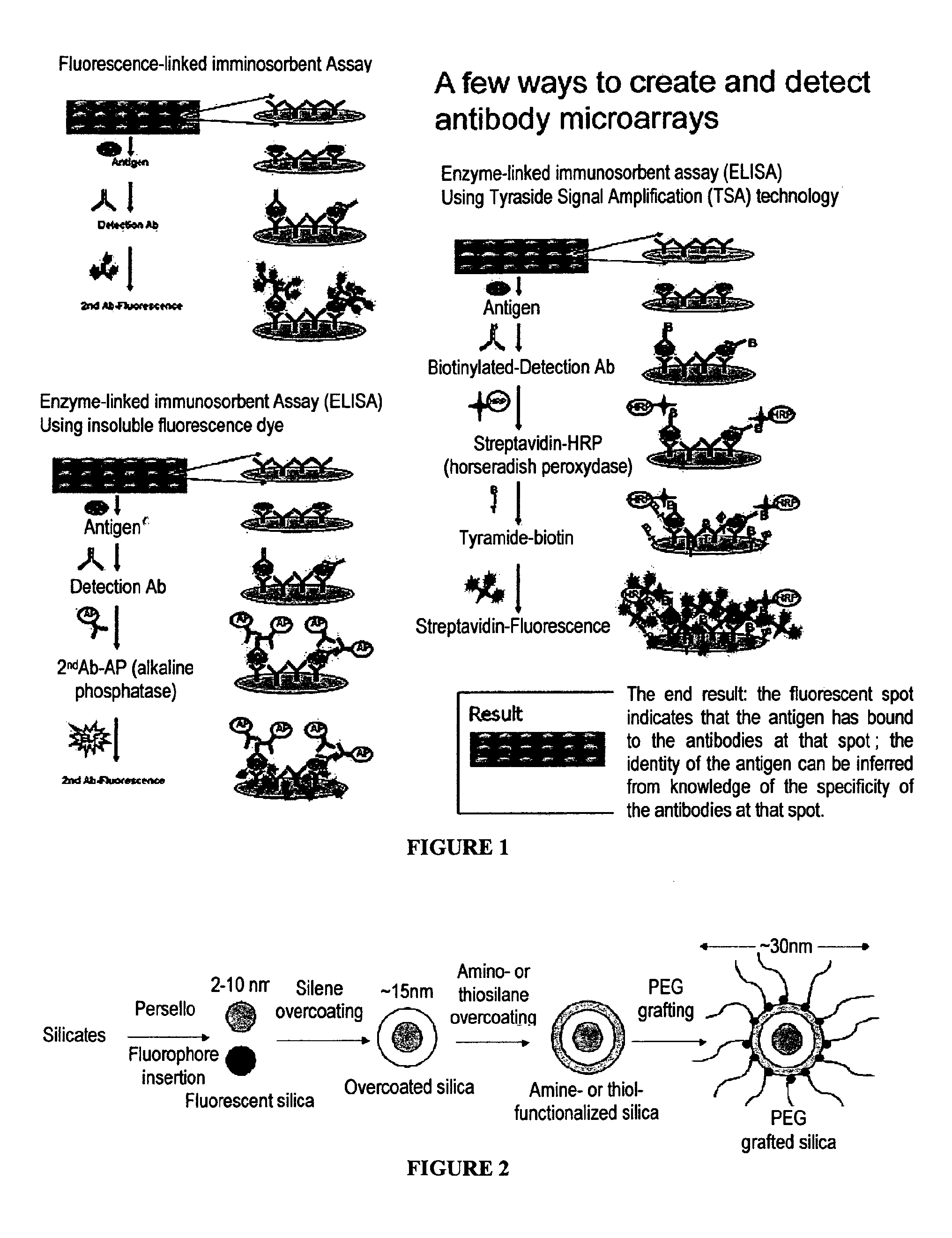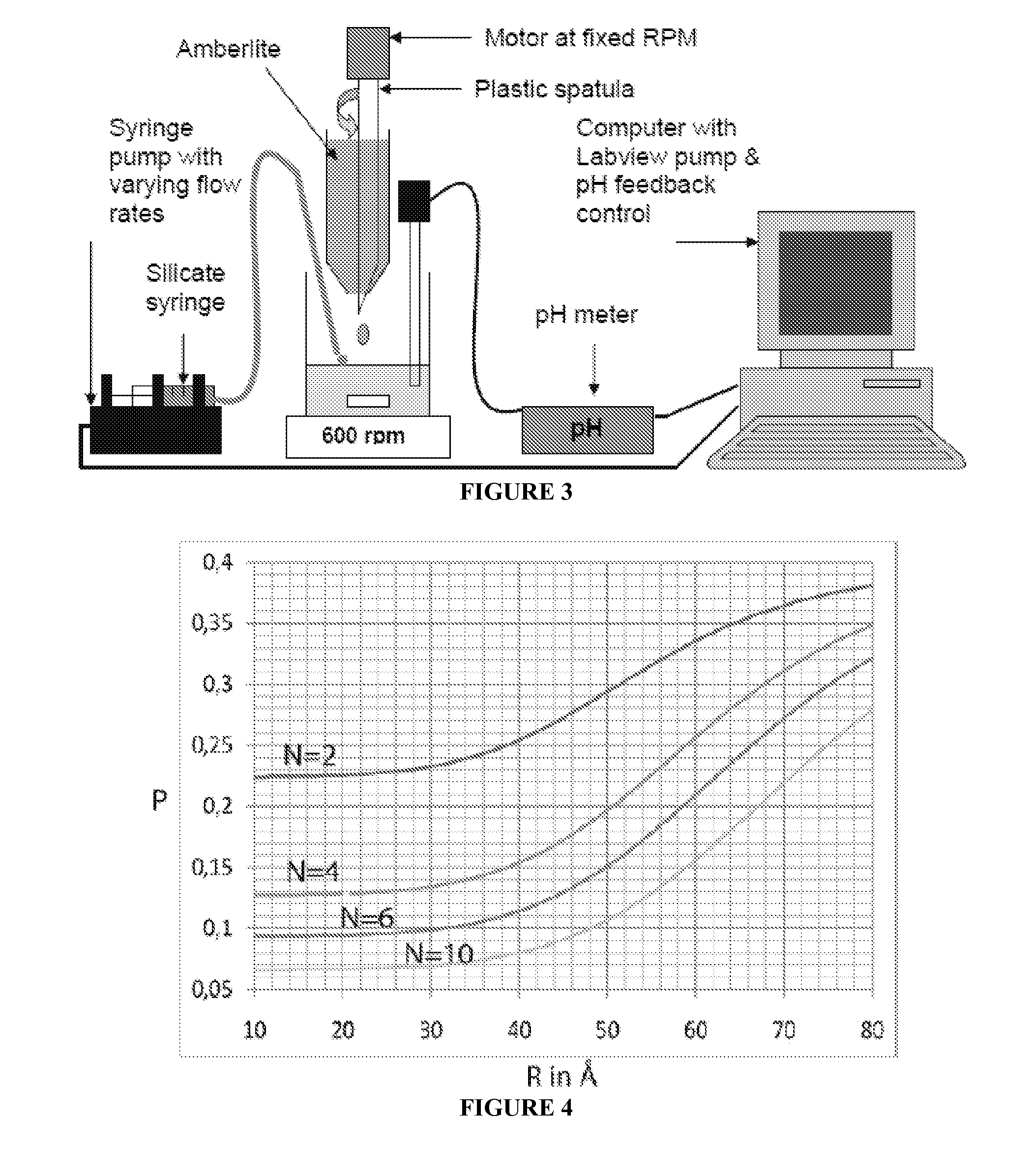Labelled silica-based nanomaterial with enhanced properties and uses thereof
- Summary
- Abstract
- Description
- Claims
- Application Information
AI Technical Summary
Benefits of technology
Problems solved by technology
Method used
Image
Examples
application 5
LISA Tests
[0239]Fluorescent nanoparticles of the inventionmay be functionalized with NHS endgroups, and then added to the blood plasma sample investigated. The nanoparticles bind to all the antigens. The mixture is added into wells functionalized with the antibody specific to the antigen that is being sorted. Antibody-antigen binding takes place; the well is then washed to remove all non-specific antigens, then a fluorescence measurement is performed. The fluorescence intensity will be proportional to the number of fluorescent-labeled bound antibodies.
Application 6: Fluorescent Marker for Microarrays
[0240]Fluorescent nanoparticles according to the invention may be used as fluorescent markers for microarrays. Nanoparticles covering antibodies or streptavidin or any other specific marker can be for instance used (see example on FIG. 1, from en.wikipedia.org / wiki / Antibody_microarray).
[0241]Using 2 nm particles will enable to bind more particles by antibody than with classically used 30...
example 1
Experimental Methods—Protocols
Protocol 1:
Synthesis Strategy Overview
[0256]The synthesis optimizations were done with inexpensive fluorophores like Fluorescein isothiocyanate, or Rhodamine B isothiocyanate. Then, the protocols were transferred to the Dylight® NIR dyes.
Silane-Dye Precursor Synthesis
[0257]A stock solution of dye (Fluorescein isothiocyanate or Rhodamine B isothiocyante, both Sigma Aldrich, or Dylight® 680-NHS and Dylight® 800-NHS, Thermo Scientific) functionalized with isothiocyanate, NHS or maleimide, in 99.9% anhydrous ethanol (Merck) or DMSO was prepared under nitrogen in a dry 1.7 mL microcentrifuge tube (Axygen); the final concentration was in the range of 5.10−4-10−2 M. Between each use, the vial was stored at 4° C. away from light and moisture. If necessary, this stock solution was diluted to 5.10−4 M with anhydrous ethanol under nitrogen before use.
[0258]A sample of this diluted dye solution (in the range of 0.1 to 1 mL) was mixed under nitrogen with 3-aminoprop...
example 2
Steady State Anisotropy Calculations
[0295]The calculations of the steady state anisotropy are given in the following equation:
rn=rmono1+(R0R)61+N(R0R)6+ret(N-1)(R0R)61+N(R0R)6
[0296]The relation between the anisotropy rn and the polarization P, is given by the following equation:
P=3rn2+rn
[0297]N is the number of dimers in the nanoparticles.
[0298]rmono is the steady state anisotropy for one fluorophore when the energy transfer between two dyes goes down to zero.
[0299]ret is the theoretical minimum value if the energy transfer is equal 100% between dyes. ret is equal to 0.016.
[0300]R is the distance between donor and acceptor.
[0301]R0 is the Förster distance at which the energy transfer efficiency is 50% and given by the equation:
K2=(cos θ−3 cos2β)2
[0302]In our case, Q is the quantum field of the fluorophore in the nanoparticles.
[0303]n is the refractive index of the silica assumed equal to 1.475,
[0304]K2 the orientation factor of the fluorophore. K2=2 / 3 is often assumed. This value i...
PUM
| Property | Measurement | Unit |
|---|---|---|
| Diameter | aaaaa | aaaaa |
| Diameter | aaaaa | aaaaa |
| Diameter | aaaaa | aaaaa |
Abstract
Description
Claims
Application Information
 Login to View More
Login to View More - Generate Ideas
- Intellectual Property
- Life Sciences
- Materials
- Tech Scout
- Unparalleled Data Quality
- Higher Quality Content
- 60% Fewer Hallucinations
Browse by: Latest US Patents, China's latest patents, Technical Efficacy Thesaurus, Application Domain, Technology Topic, Popular Technical Reports.
© 2025 PatSnap. All rights reserved.Legal|Privacy policy|Modern Slavery Act Transparency Statement|Sitemap|About US| Contact US: help@patsnap.com



